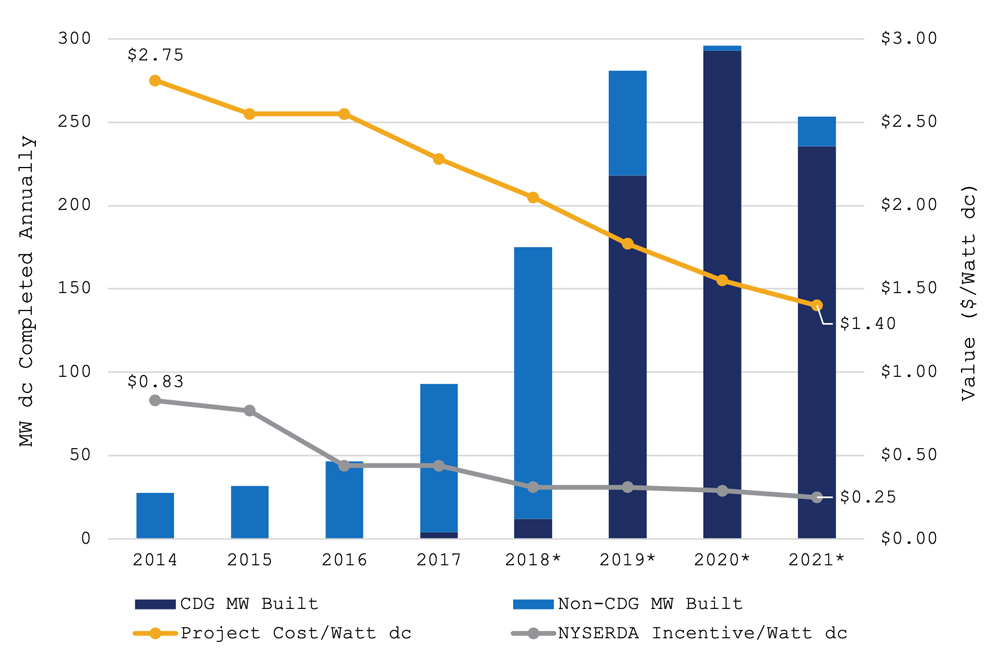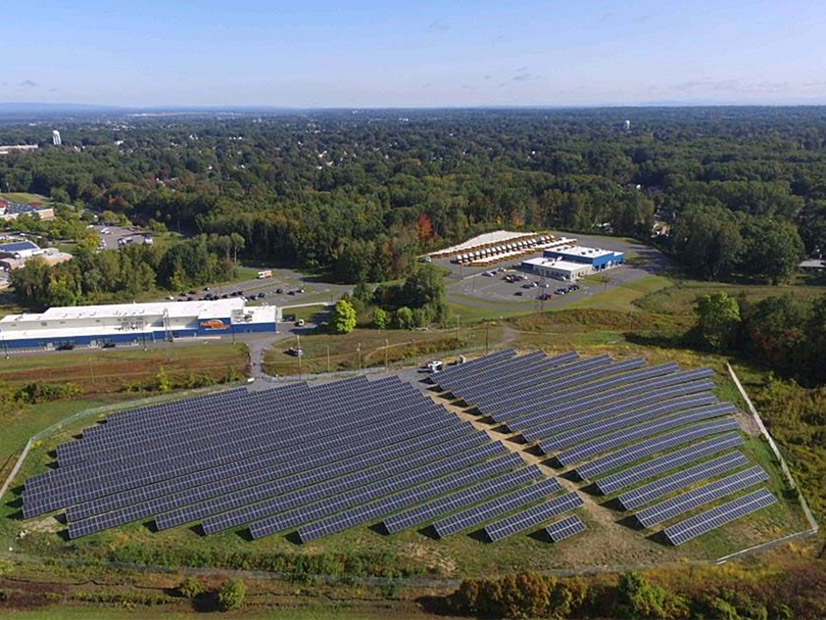Consumers, environmentalists, utilities, developers and labor organizations expressed support for New York’s plan to expand state solar incentives by $1.5 billion through 2030, but many are concerned with who pays, how much, and how often (Case No. 21-E-0629).
The groups filed comments in response to the Public Service Commission’s roadmap for achieving 10 GW of distributed solar by the decade’s end. Installed distributed solar and projects under development already total more than 93% of the previous state goal of 6 GW by 2025. The roadmap defines distributed solar as including residential, non-residential and commercial/industrial projects, including community distributed generation, distinguishing them from utility-scale projects (greater than 20 MW). (See New York Issues 10 GW Solar Roadmap for 2030.)
McGowan Southworth, a solar advocate and consultant said owners of small buildings that have taken out solar loans tied to the value of solar production under the NY-Sun program will not be able to make monthly loan payments if Con Edison doesn’t distribute value stack credits accurately and consistently.
“This would in turn harm their credit [and] also erodes fragile trust between the end customer and all parties related to solar, utility and PSC included,” Southworth said. “Would the PSC allocate funds for auditing community solar accounts on behalf of subscribers who are otherwise bearing this cost and administrative headache?”
Cost Concerns
New York utility customers already are overburdened and contribute billions of dollars annually to a large and rapidly growing list of customer-funded programs and initiatives, said Multiple Intervenors (MI), an ad hoc group of more than 50 large commercial, industrial and institutional energy consumers.
The state’s economy is continuing to experience the disruptive impacts of the COVID-19 pandemic, as well as energy prices that have skyrocketed this year, the group said.
MI asked for scrutiny of costs, as it did recently regarding National Grid transmission projects proposed for western New York. (See Large NY Consumers Oppose National Grid Tx Upgrades.)
“The solar roadmap fails to demonstrate why certain proposed costs, such as supplementing the labor costs of solar developers, even should be funded by utility customers,” MI said. “The commission … should evaluate such proposals collectively with the other programs and initiatives that customers already are being required to fund. This type of comprehensive evaluation is long overdue and should be undertaken expeditiously.”

New York City said it supports expanding incentives, noting that for Con Edison customers, the average bill impact in 2024 — the year of highest impact — is estimated to be 0.52% for residential customers and 0.97% for commercial and industrial (C&I) customers.
“The estimated bill impacts are modest and reasonable when weighed against the benefits that customers should realize in return for their investment,” the city said. Solar developer Ecovis Group said the rules requiring the payment of prevailing wages for distributed energy resources over 1 MW will tax the finances of small local companies.
“We are asking the PSC to add requirements for monthly progress payments to the contractors for work completed the previous month. This will help to offset cash flow changes,” Ecovis said. “Developers are going to receive additional funds through [New York State Energy Research and Development Authority] grants; however contractors will bear the brunt of the cash requirement.”
Climate Jobs NY, a coalition of labor unions representing 2.6 million workers in the state, said it supports the program expansion, which the state says should create 6,000 new jobs.
Developer Incentives
The New York Power Authority said it supports the roadmap, but that uncertainty around the availability of future incentives has caused customers working with NYPA to hesitate on committing to new projects.
“This observation is particularly pronounced amongst customers in Con Edison’s service territory, where project economics are challenging due to high labor and installation costs, along with the siting constraints inherent to the region’s dense urban environment,” NYPA said.
A group of environmental organizations including Scenic Hudson, Natural Resources Defense Council and the Sierra Club said that NY-Sun should include an incentive for projects that include agrivoltaics — the co-location of solar-powered projects and agriculture — similar to those for landfill, brownfields and parking canopy projects.
“Providing such incentives in the NY-Sun program will have several benefits, including achieving distributed solar targets, supporting the agricultural economy, and promoting community acceptance of projects in rural and farming communities that might otherwise object to projects as a threat to farmland and community character,” the environmentalists said.
The Joint Utilities, representing the investor-owned utilities in New York, said they are developing a pilot to bring more solar energy to underserved communities in support of the state’s expanded target.
“In addition, the mid-point review should explore more funding sources and evaluate incentive levels so that necessary modifications can be made before funding is exhausted,” the utilities said.
New York City said Con Edison deserves a bigger slice of the incentive pie, given its outsize share — 39.6% — of total electricity sales in the state.
The city supports the proposal to segment Con Edison incentives based on system size, which will ensure that smaller projects can continue to be built.
The city recommended, however, that the commission modify the roadmap’s proposals for Con Edison and create three tiers of incentives for non-residential projects versus the proposed two tiers. The city also called for reducing the base incentives for non-residential projects to encourage up to 568 MW of new distributed solar in Con Edison’s territory. It also said the state should re-allocate some of the base incentive dollars to increase the proposed community adder for community solar projects in Con Edison’s territory.
Community organizers WE ACT for Environmental Justice said that “a proposal of this size, without comprehensively planning for equitable outcomes, could do more harm than good,” and that the investment must comply with the statutory requirement that disadvantaged communities receive 40% of overall benefits of state spending on clean energy and energy efficiency programs.
“Right now, the only benefit being accounted for and attributed to disadvantaged communities is bill discounts of 10%. The benefits of distributed solar are plentiful, and bill discounts are one very small piece of that pie,” said WE ACT policy director Sonal Jessel.


